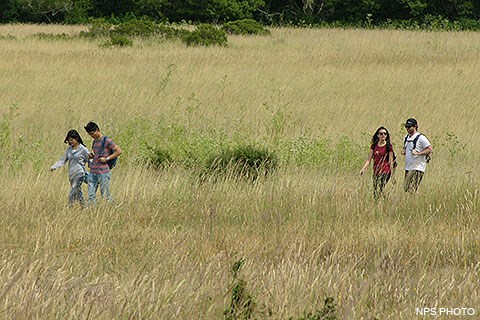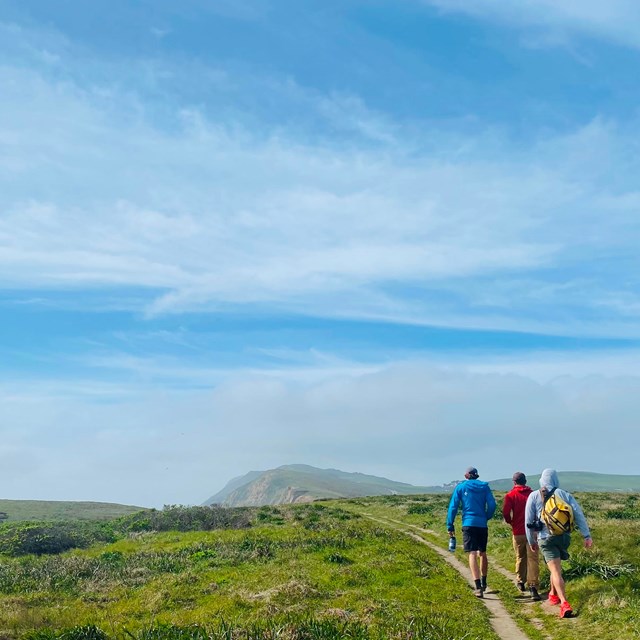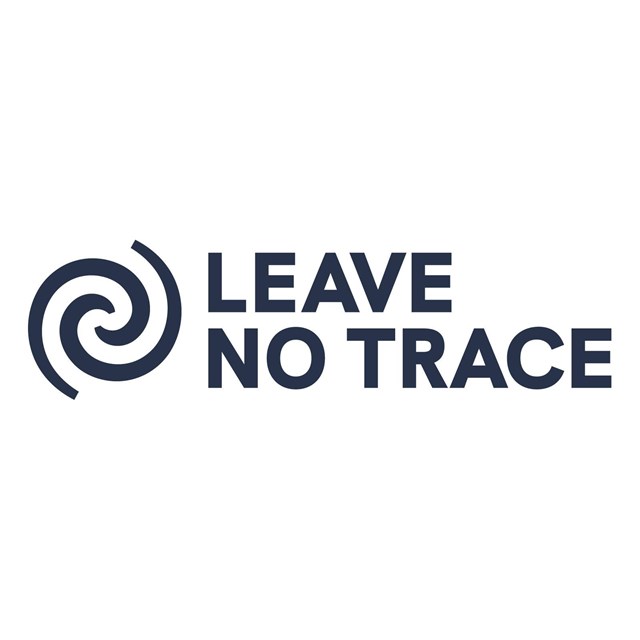
The National Seashore has about 240 kilometers (150 miles) of hiking trails to explore. Trail maps are available at the Bear Valley Visitor Center and on our Maps page. There are many ways to customize your hike to accommodate your physical and time limitations. Stop by the Bear Valley Visitor Center for current trail information and suggested hikes, as well as updates on trail advisories and closures. Trail Etiquette and SafetyTo keep your adventure safe and enjoyable, and to protect park resources, please observe the following. Limit your party to 25 peopleDay users traveling within designated wilderness areas may not travel in groups of more than 25 persons. Large groups create noise and a presence that disturbs wildlife and interferes with other people in the area who are looking for a wilderness experience away from crowds and noise. Observe trailsStay on trails to prevent erosion as well as to better avoid poison oak, stinging nettles, ticks, and yellow jackets. Do not shortcut on switchbacks. Observe trail closures and warning signsPlease observe all trail closures and barriers. Trails are closed for a variety of reasons, such as for visitor safety, to protect endangered species, to prevent erosion, and/or to allow new sections of trail to harden. Visitors who disregard trail closures may endanger themselves and any potential rescuers, harm threatened and endangered species, exacerbate erosion, or prevent new sections of trail from properly hardening, which results in the degradation of the trail surface, which in turn may require the closing of the trail for repair. Thank you for your cooperation. Yellow JacketsIn the summer and fall, reports of yellow jacket activity along trails increase. Park staff will post notices at appropriate trail junctions warning hikers of the presence of yellow jacket nests located in close proximity to the trail as nests are discovered and/or reported. Please use an alternate route if you are allergic, want to avoid any risk of yellow jacket stings, or are riding a horse. Please notify park staff at 415-464-5100 x2 x5 if you encounter a swarm of yellow jackets along a trail that has yet to be posted. Visit our Your Safety Around Yellow Jackets for more information. Avoid park residences, ranch complexes, and other buildingsAvoid park residences, operational complexes for ranches, and other buildings, aside from visitor use facilities. Employee housing as well as park administrative, maintenance, operations, and storage facilities, including, but not limited, to access roads, outbuildings, grounds, and docks, are closed to public use. Caution along cliffsStay away from cliff edges. Loose soil can give way suddenly and you may fall. Do not climb cliffs. ClothingDress appropriately. Wear layered clothing and be prepared for changing conditions. Food & waterAlways carry food and water for longer hikes. Dehydration is a common cause of exhaustion, fatigue and headaches. Raccoons and other animals can quickly find and ransack unattended food and daypacks. Drinking waterThe protozoan Giardia lamblia may be present in natural sources of water and can cause severe illness. Do not drink water from streams and all other natural sources without treating. Water may be treated by boiling, filtering, or using iodine or other chemical water purifiers. Potable drinking water is available at visitor centers and in campgrounds. Invasive WeedsTo help control the spread of non-native plants, please:
More Information
HorsesIf horses are passing on the trail, step to the downhill side and greet the rider so the horse knows you are there. Do not touch the animals. CattleIf you plan to hike a trail that leads through cattle pasture, please read Understanding Working Rangelands: Sharing Open Space: What to Expect from Grazing Livestock (1,314 KB PDF). By understanding basic cattle behavior, you can give yourself a better chance to predict how cattle are likely to react to your presence and in response to your actions. This will help make your hike through these areas safer and more enjoyable. Trail informationThere may be trail advisories and/or closures in effect. Please check at the visitor center before heading out on the trails. Hiking Tips:
Multimedia:Hikers, campers, and other visitors to Point Reyes may find our Wilderness Videos page to be of interest. There we feature multiple videos about the Phillip Burton Wilderness and Leave No Trace® outdoor ethics.
|
Last updated: May 15, 2025



